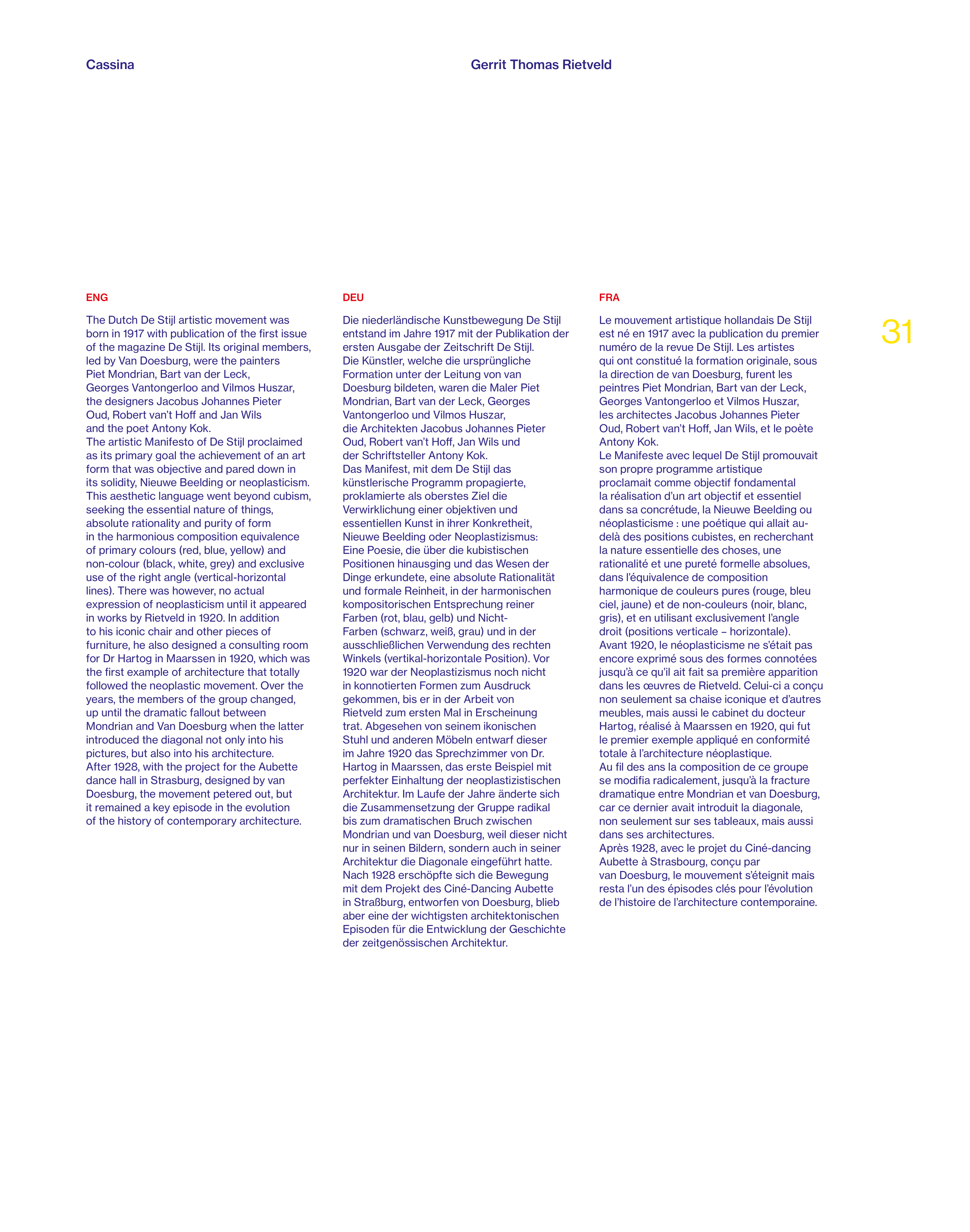The Dutch De Stijl artistic movement was
born in 1917 with publication of the fi rst issue
of the magazine De Stijl. Its original members,
led by Van Doesburg, were the painters
Piet Mondrian, Bart van der Leck,
Georges Vantongerloo and Vilmos Huszar,
the designers Jacobus Johannes Pieter
Oud, Robert van’t Hoff and Jan Wils
and the poet Antony Kok.
The artistic Manifesto of De Stijl proclaimed
as its primary goal the achievement of an art
form that was objective and pared down in
its solidity, Nieuwe Beelding or neoplasticism.
This aesthetic language went beyond cubism,
seeking the essential nature of things,
absolute rationality and purity of form
in the harmonious composition equivalence
of primary colours (red, blue, yellow) and
non-colour (black, white, grey) and exclusive
use of the right angle (vertical-horizontal
lines). There was however, no actual
expression of neoplasticism until it appeared
in works by Rietveld in 1920. In addition
to his iconic chair and other pieces of
furniture, he also designed a consulting room
for Dr Hartog in Maarssen in 1920, which was
the fi rst example of architecture that totally
followed the neoplastic movement. Over the
years, the members of the group changed,
up until the dramatic fallout between
Mondrian and Van Doesburg when the latter
introduced the diagonal not only into his
pictures, but also into his architecture.
After 1928, with the project for the Aubette
dance hall in Strasburg, designed by van
Doesburg, the movement petered out, but
it remained a key episode in the evolution
of the history of contemporary architecture.
Die niederländische Kunstbewegung De Stijl
entstand im Jahre 1917 mit der Publikation der
ersten Ausgabe der Zeitschrift De Stijl.
Die Künstler, welche die ursprüngliche
Formation unter der Leitung von van
Doesburg bildeten, waren die Maler Piet
Mondrian, Bart van der Leck, Georges
Vantongerloo und Vilmos Huszar,
die Architekten Jacobus Johannes Pieter
Oud, Robert van’t Hoff , Jan Wils und
der Schriftsteller Antony Kok.
Das Manifest, mit dem De Stijl das
künstlerische Programm propagierte,
proklamierte als oberstes Ziel die
Verwirklichung einer objektiven und
essentiellen Kunst in ihrer Konkretheit,
Nieuwe Beelding oder Neoplastizismus:
Eine Poesie, die über die kubistischen
Positionen hinausging und das Wesen der
Dinge erkundete, eine absolute Rationalität
und formale Reinheit, in der harmonischen
kompositorischen Entsprechung reiner
Farben (rot, blau, gelb) und Nicht-
Farben (schwarz, weiß, grau) und in der
ausschließlichen Verwendung des rechten
Winkels (vertikal-horizontale Position). Vor
1920 war der Neoplastizismus noch nicht
in konnotierten Formen zum Ausdruck
gekommen, bis er in der Arbeit von
Rietveld zum ersten Mal in Erscheinung
trat. Abgesehen von seinem ikonischen
Stuhl und anderen Möbeln entwarf dieser
im Jahre 1920 das Sprechzimmer von Dr.
Hartog in Maarssen, das erste Beispiel mit
perfekter Einhaltung der neoplastizistischen
Architektur. Im Laufe der Jahre änderte sich
die Zusammensetzung der Gruppe radikal
bis zum dramatischen Bruch zwischen
Mondrian und van Doesburg, weil dieser nicht
nur in seinen Bildern, sondern auch in seiner
Architektur die Diagonale eingeführt hatte.
Nach 1928 erschöpfte sich die Bewegung
mit dem Projekt des Ciné-Dancing Aubette
in Straßburg, entworfen von Doesburg, blieb
aber eine der wichtigsten architektonischen
Episoden für die Entwicklung der Geschichte
der zeitgenössischen Architektur.
Le mouvement artistique hollandais De Stijl
est né en 1917 avec la publication du premier
numéro de la revue De Stijl. Les artistes
qui ont constitué la formation originale, sous
la direction de van Doesburg, furent les
peintres Piet Mondrian, Bart van der Leck,
Georges Vantongerloo et Vilmos Huszar,
les architectes Jacobus Johannes Pieter
Oud, Robert van’t Hoff , Jan Wils, et le poète
Antony Kok.
Le Manifeste avec lequel De Stijl promouvait
son propre programme artistique
proclamait comme objectif fondamental
la réalisation d’un art objectif et essentiel
dans sa concrétude, la Nieuwe Beelding ou
néoplasticisme : une poétique qui allait au-
delà des positions cubistes, en recherchant
la nature essentielle des choses, une
rationalité et une pureté formelle absolues,
dans l’équivalence de composition
harmonique de couleurs pures (rouge, bleu
ciel, jaune) et de non-couleurs (noir, blanc,
gris), et en utilisant exclusivement l’angle
droit (positions verticale – horizontale).
Avant 1920, le néoplasticisme ne s’était pas
encore exprimé sous des formes connotées
jusqu’à ce qu’il ait fait sa première apparition
dans les œuvres de Rietveld. Celui-ci a conçu
non seulement sa chaise iconique et d’autres
meubles, mais aussi le cabinet du docteur
Hartog, réalisé à Maarssen en 1920, qui fut
le premier exemple appliqué en conformité
totale à l’architecture néoplastique.
Au fi l des ans la composition de ce groupe
se modifi a radicalement, jusqu’à la fracture
dramatique entre Mondrian et van Doesburg,
car ce dernier avait introduit la diagonale,
non seulement sur ses tableaux, mais aussi
dans ses architectures.
Après 1928, avec le projet du Ciné-dancing
Aubette à Strasbourg, conçu par
van Doesburg, le mouvement s’éteignit mais
resta l’un des épisodes clés pour l’évolution
de l’histoire de l’architecture contemporaine.
ENG
DEU
FRA
31
Cassina
Gerrit Thomas Rietveld


